To start, what are your names and potions with the group?
Quinton Wong: My name is Quinton Wong. While we are both co-presidents, our role is to delegate all the tasks of our growing club and liaison with external organizations and other institutional clubs because we have also worked with the University of Alberta’s design club as well.
Angel Poon: My name is Angel Poon. This is my second year as an executive on the club. I volunteered the first year and then was the vice president last year, and this year we decided to go with co-presidency, and we didn’t elect ourselves. This was a group decision. We were very democratic about this process. A lot of our work involves talking to staff and students, finding out what ways we can promote a better sense of community within the design community as a whole.
How long has this student group been around, and when did it start?
AP: It is a little bit of a questionable beginning, just because there isn’t really a definite day that we were ever aware of. The beginning of the Design Students Organization (DSO) began, I would say, between 2009 and 2010. Then the club kind of died off until 2015, and so since we’ve been back on, it has been rebuilding that foundation and rebuilding a name.
Why was this student group started?
QW: I think it was just to provide an extra resource for students to gain knowledge outside what we learn in class, so things relating to freelancing and getting your foot through the door with the industry, basically connecting students to resources. One of the bigger staple events was Orange, the design conference, which involved a mixer night and a speaker day and workshops. That was how we aimed to provide that extra bit of knowledge we don’t get in the class.
What would students usually be able to expect, and what can they expect now?
AP: Normally, this year would have been huge for us. We expanded our executive team to 14 members. Every week we would usually bring in a speaker for something we called Limelight lunches, which allowed us to listen to different industry people on various topics. We also run Lemonade Live, which is a critique group. A big portion of design is feedback and criticism from your professors and your peers, so to have that safe space for students to put their work up and get constructive criticism back from the community is really important for us. This year because of COVID, we transitioned that into Discord, so we have it every Wednesday and the students can hop on to the channel, present their ideas and talk about it. We also have Orange, which is our big event in March. We recently collaborated with the U of A with their pop-up design shop, Built, where students can sell merchandise.
QW: We started diving into creating more merchandise and ended up being the top seller at the Built pop-up shop, so we might explore doing more of that to fundraise money to hold more events and mixers. Last year we were hoping to start a game night to foster more community within our design students.
What types of design does the group incorporate, and do you do freelance work?
AP: We personally do not do design for groups, but we would be happy to put you in contact with our design students that would be more than happy to either volunteer or be a part of your club if you need a design student to be part of your executive team and help with all your design work. We have also had requests from businesses and other groups in the past to contract out work, which is where they are looking for a design student for paid work.
QW: I think there is an extensive breadth of knowledge across our whole program. There is someone for everything. There are those into motion graphics, social media, music videos, and so on.
AP: I think it depends on what student you talk to and their interest. For example, I would be more interested in motion graphics and illustration and branding like logos and stuff. But Quinton is more into website design and UX and UI, and other students are really into photography and videography or architecture. That’s the great part about it. We can always find a designer for you.
Is the group strictly geared towards design students, or could others with an interest in design join?
AP: I think we have only had one student that wasn’t strictly design, but most of the students who joined the group have been design students. Because we haven’t experienced it, we don’t really have too many parameters. A lot of the roles in our group are design-based. We do it via an election process. We would be open to it depending on what roles and events we are looking to start up, but it just seems to be design students for right now.
Is there anything that you would like potential student members to know?
AP: It would be good for everyone to know that we are all friendly. A lot of people, even new clients, will say, “I don’t know much about design or how you’re paid. Can I ask you these questions? ” Yes, absolutely you can. Students need to know they have a space to ask design questions.
QW: We are an open, collaborative, and safe space for sharing critique on design. If there were to be someone trying to make a logo, for example, even if they weren’t part of our group, we would be happy to critique it. We are an outlet to get design feedback because it’s good practice for us, which is what we are trying to make out of Lemonade Live because it’s essential to receive critique but also give critique.
Edited for length and clarity.





0 Comments